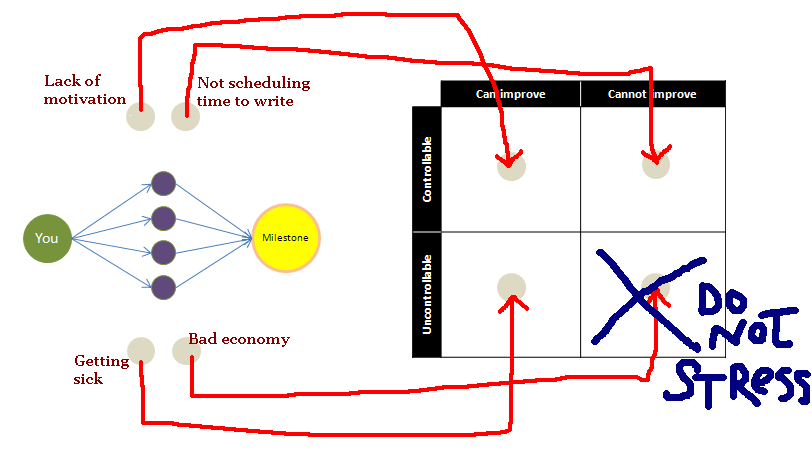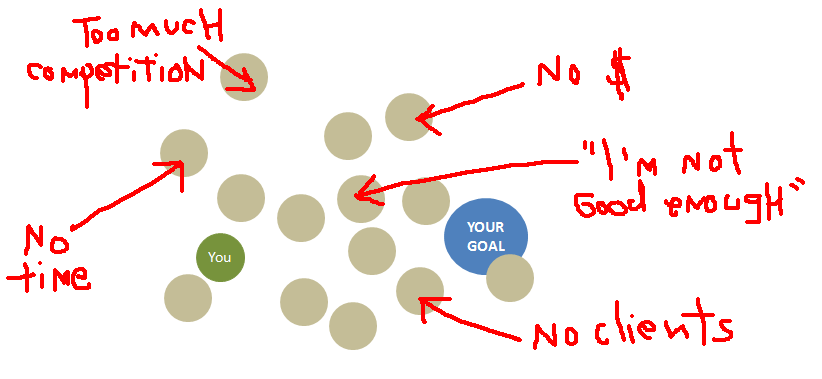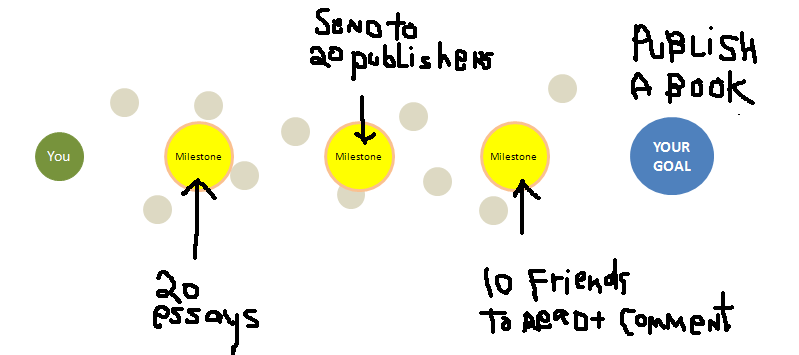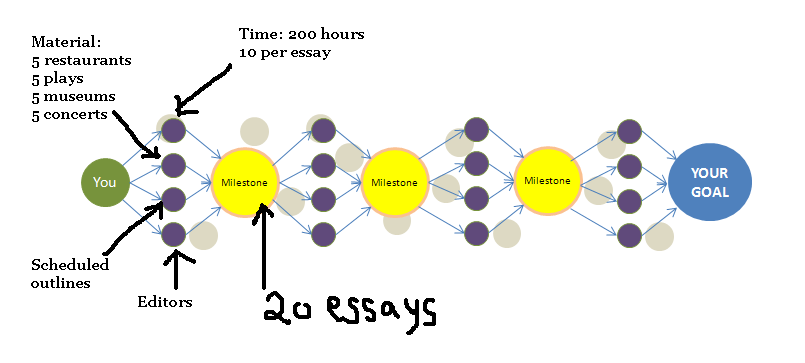How to accomplish anything

The difference between a titan and an average schmo is outlook and empowerment. Joe Schmo sees all of the obstacles between himself and his dream, whereas Thomas Titan sees the path around and over those obstacles to his destination. So if you are one of the lucky few who knows exactly what his desired destination is, then the only thing that is stopping you from getting there is yourself. Here is a guide, to be used literally, figuratively or as simple inspiration to help you achieve your goals.
1. Visualize your goal.

Pretend that your goal was this blue bubble here. Think about it. Immerse yourself in what that feels like. What would your business or your life look like if you accomplished it? Let yourself dream.
2. Picture yourself now in relation to the goal.

If this is how you feel, it’s ok! and natural. Perhaps you view these grey bubbles as obstacles. We just need to re-frame the way you view them. Determine whether those obstacles are controllable or uncontrollable. Let’s put those aside, we’ll come back to those later.
3. Define milestones.
If you break down a huge goal into smaller digestible goals or milestones, it will make your feat much more achievable. Each milestone should be viewed as a win and cause for celebration.
Everyone needs milestones to tell them that they are on the right path. Even if you rode the NJ Turnpike from exit 8 to exit 16 every single day and knew exactly how many miles and minutes this ride took you… if one day someone took down all of the signs for each exit between 8 and 16, you would inevitably get confused. We rely on milestones in everything we do: Wednesday is “hump day” signaling that I’ve gotten through 1/2 of the work week, 3:00 is my afternoon coffee break, the second sun salutation is the halfway point in my yoga class. Milestones rejuvenate and comfort you. Not only do they signal progress, but they also help make those obstacles seem less daunting. When the goal sometimes seems out of reach, you can focus your short-term lens on the nearest milestone, rather than the nearest obstacle.

4. Understand what you need to do to reach your next milestone
Once you understand what factors move you along your path to get you to your next milestone, then you can plan for and around those factors. For instance, in this example above, I know that I need 200 hours to write 20 essays, which is a major milestone for my goal to publish a book. Please note this is just an example, I don’t know what the major milestones for writing a book would be, but continue humoring me here. Knowing that I need 200 hours to sit and write and that I have 10 hours a week to sit and write, it will take me roughly 20 weeks to write all 20 essays. Building in time for weekends off and such, I figure that Memorial Day is a good date by which to complete this milestone. And my mini-milestones might be: Thanksgiving: 5 essays, President’s Day: 10 essays and so on.
For instance, in this example above, I know that I need 200 hours to write 20 essays, which is a major milestone for my goal to publish a book. Please note this is just an example, I don’t know what the major milestones for writing a book would be, but continue humoring me here. Knowing that I need 200 hours to sit and write and that I have 10 hours a week to sit and write, it will take me roughly 20 weeks to write all 20 essays. Building in time for weekends off and such, I figure that Memorial Day is a good date by which to complete this milestone. And my mini-milestones might be: Thanksgiving: 5 essays, President’s Day: 10 essays and so on.
5. Advanced step: Anticipate risk
Before, when we first visualized ourselves in relation to our goal, there were a bunch of these big grey bubbles clouding our eyes. Now, they are much less daunting, because there are attainable milestones that take the intimidating nature of those grey bubbles away. Nevertheless, we must try to understand these obstacles.
Some say not to focus on the obstacles but on the end goal. I partly agree with that. You shouldn’t focus on your obstacles. However, you do need to fully understand these nemeses in order to defeat them! Understand all of the things that could set you back and determine if they are controllable/ preventable (i.e. you cannot control the weather) and if they can be impacted once encountered (i.e. you cannot improve the weather).
Try to list out everything that could set you back. This is a crucial exercise that will need you to think outside of the box. In essence, I am asking you to be pessimistic and wonder what could go wrong. This does not mean you are planning for the worst, it means that you are preparing for the worst.
Next, draw four quadrants: a box with two lines across the middle vertically and horizontally. Label the left column “can improve”, the right one “cannot improve”. Label the top row “controllable” and the bottom row “uncontrollable”. Now take your list of risks and categorize them. This will put them in the order in which you should focus your energies.
First, focus your energies on doing everything you can to prevent those risks in this top right quadrant: things that you can prevent but can’t do anything about once it happens, like not scheduling in time to write. If you know that you are prone to quickly fill up your schedule and run out of time to write, PLAN TIME FOR IT. No excuses. Write it into your planner of your google calendar. If you know that you are often easily distracted by emails and phone calls while you are writing, TURN OFF ALL ELECTRONICS during your scheduled writing time. You can’t just go into a task and expect that it will get done. We all know this is way too rosy of a picture. You need to anticipate the things that will keep you from accomplishing your objective and plan ahead for those things.
Next, plan for those things that you can both prevent and do something about in the top left quadrant, like having a lazy day. Keep yourself motivated daily with pep talks and schedules and rewards when you accomplish something.
Finally, prepare for those things that you can’t do anything to keep from happening but can do something about once they do in the bottom left quadrant. If you get sick, for example, you will not whine and cry and fight the cold as you relapse over and over again.
No.
You will immediately take 2 vitamin C’s, an airborne, ask your husband to make you chicken soup, and allow yourself 48 hours of bedrest.
Finally, this bottom right quadrant… throw everything that you know about it out. If you cannot control it or impact it, don’t waste your energy thinking about it; it is counterproductive. This is a wasteful activity that many people use as a crutch to keep them from accomplishing their dreams. They blame the weather, the economy and other such external factors completely outside of their control. Don’t do that. It’s lame.
6. Now execute!
Now you have a plan.
You know what your goal is.
You know the milestones to get there You know how you need to achieve each milestone.
And you have anticipated and contained each risk/ obstacle along the way.
 The hardest part is done. Now you just go do it!
The hardest part is done. Now you just go do it!
I love this Jane